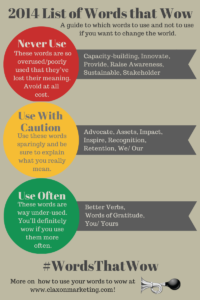
“I would love to get together for coffee.”
“Would love to get together for coffee.”
The difference between these two sentences may seem subtle, but it’s actually staggering:.
The difference, obviously, is that the second sentence drops the “I”. Why is this so earth-shattering? And why should you care? Because pronouns reflect power dynamics. Pronouns could reveal just how many cups of coffee you may need to have before they cut you a check.
When you’re in the power position, you use pronouns less often. You’ll drop them altogether. You won’t notice you’re doing this. We all do it subconsciously.
Using the example above, the second response would indicate that the donor is still mulling over whether your organization will be on their Philanthropic Hit Parade. They’re holding their cards close to their chest, one eyebrow raised. Their pronoun-free response is their subtle way of saying, “Still on the fence, dear fundraiser. Make your case and I’ll ponder.”
We can figure all of this out simply by looking at a measly pronoun? Yep, that’s right. Pronouns. I, we, he, she, us, them. These itsy, bitsy words matter. A lot.
“I” is the single most frequently used word in spoken and written texts. Indeed, thanks to Professor James W. Pennebaker and his research team, we know that “I” accounts for 3.64% of all words used. That alone is interesting as it reflects what we care about most–ourselves. To be clear, being focused on yourself doesn’t make you a self-centered jerk. It means you’re human and, therefore, hard-wired to focus on survival. Just cuz a tiger is no longer chasing you across a tundra doesn’t mean your brain isn’t fighting to survive. It just looks a little different these days.
Focusing on ourselves is inevitable. And our language reveals this.
Pronouns and the larger category that they fall under called “function words”, are your linguistic BFFs. Paying attention to them can pay off in a big way. The more you use “you” and “your”, and the less you use “I” and “We”, the more you speak directly to what the donor (as a human being) cares about most–him or herself.
If your goal is to engage donors, mind your p’s and q’s and absolutely, positively pay attention to your pronouns.
